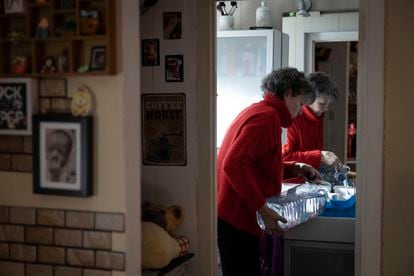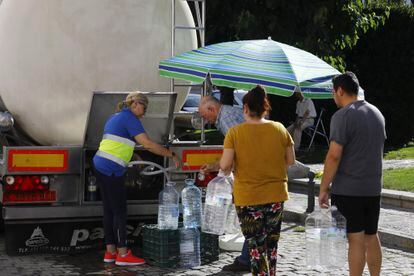At a time when the rains are returning to many areas of the country, the drought is ravaging the south and northeast of the Peninsula. A good part of Spain's reservoirs have been adding hectometers in autumn and winter for when they are needed in the driest months (some basins such as the Miño-Sil or the Duero are even above the average of the last 10 years), But after several years of water shortages, the two most affected communities, Andalusia and Catalonia, begin 2024 with exhausted water reserves. According to this week's bulletin from the Ministry for the Ecological Transition, the reservoirs in the worst situation are those of the Guadalquivir basins (at 19.3% of their capacity), Segura (18.9%), Andalusian Mediterranean Basins (18, 8%), Internal Basins of Catalonia (16.8%) and Guadalete-Barbate (14.5%). The drought is taking a special toll on the Catalan and Andalusian communities, where tougher supply restrictions are already being prepared and they are considering having to resort to transporting water by boat.
In the case of Catalonia, which closed 2023 with a level of precipitation between 30% and 50% lower than the average of the last 30 years due to the worst drought in the territory since there are records, it is the first time that its reservoirs are below 17%. Although there will be some rain in the coming days, the Catalan Executive (Esquerra Republicana) has recognized that all forecasts indicate that a state of emergency will be reached.
Unlike large cities like Barcelona, where residents still see water coming out of the tap, the interruption of supply during some hours of the day or night is common in around 70 municipalities of the 202 affected in the metropolitan area of the Catalan capital and some towns of Girona. These are localities that have squeezed everything they could from the aquifers, through wells, to supply themselves and that are currently supplied with tanker trucks. Vallirana (23,000 inhabitants, Barcelona), L'Espluga de Francolí (about 4,000 inhabitants, Tarragona) or Cabrera d'Anoia (1,600 inhabitants, Barcelona) are just some examples where residents collect jugs, drums, buckets and even tanks of 500 or more liters that they fill to overcome the hours in which they cannot open the tap.

Albert Garcia
In L'Espluga de Francolí, where there is no access to water from 8 p.m. to 10 a.m. the next day (2 p.m.), the City Council paid 20,000 euros per week at the end of November for 140 tanker trucks to reach the town. In Cabrera d'Anoia, where the tap has been cut off for up to 16 hours and leaks in the supply network are constant, the situation is similar. “Some have sacrificed their vacations to be able to have water at home. Others cannot even buy the tank,” says Elisabet Carbonell, a resident of Cabrera d'Anoia and spokesperson for the Aigua Per Cabrera platform, about the investment in water tanks. And Vallirana became the first town to voluntarily request the emergency scenario of the Special Drought Plan (PES) after the aquifers had only three meters of 70 with water. Other municipalities have reached solidarity agreements to guarantee the population's consumption. In Castellbell i el Vilar (4,000 inhabitants, Barcelona), the City Council has connected a 1.8 kilometer pipeline to receive 80,000 liters from Marganell, the next town, where they have access to the resources of the Llobregat river, one of the main fountains of Catalonia next to the Ter. In all these municipalities, where thousands of euros of subsidies have been requested to alleviate the drought, human consumption per inhabitant per day is limited to 210 liters and it has been prohibited to water parks and gardens, wash cars, clean roads or fill swimming pools. with drinking water.
Information is the first tool against climate change. Subscribe to it.
Subscribe
In December, the Generalitat already introduced new modifications to the PES to combat the serious water shortage, which included new restrictions on water-intensive industrial activities, which cannot be started until the drought is overcome, and the closure of showers in sports centers that have a swimming pool or must water the grass for federated use. In addition to reducing the ecological flow of the Llobregat, Ter and Muga rivers. David Mascort, advisor to Climate Action, even suggested that the population stop using the gym showers: “We know that these are decisions that many will not like, but the situation is very complicated.” While working against the clock on the expansion and construction of desalination plants, purifiers and water regenerators to increase the volume of water production, the Executive of Pere Aragonès has reiterated that, in the most serious scenario of the drought, they will bring water in ships to the port of Barcelona to guarantee the supply of the population, for which the Catalan president considers the collaboration of the Government of Pedro Sánchez “essential”. The entry into this difficult phase, expected in January, will mean that the almost six million Catalans affected will reduce their consumption in stages in three different stages that will vary depending on the rainfall. In the first, 200 liters will be consumed, 180 in the second and 160 in the third.

Restrictions and lost crops
In Andalusia, if it does not rain incessantly before summer, much worse restrictions than the current ones are also expected, which already affect 3.5 million people. At the moment, the weather forecast does not show major rain on the horizon this spring. Desperation is spreading in the countryside due to the loss of crops, but also in tourist cities and municipalities, because the water cuts that already affect dozens of towns will expand to many more if the drought does not turn around.
The Andalusian Junta, which governs the PP, plans drastic measures and uses tanker ships as early as March to transport water and supply the population with the most extreme drought, such as the one that resides on the Costa del Sol, in Malaga, and the Campo de Gibraltar, in Cádiz. In parallel to the ships, the Drought Plus plan, endowed with 71 million, will pay for new boreholes, installations of treatment plants and the conditioning of portable desalination plants, among other measures, although there are no dates yet.
“We have now been in a drought situation for 94 months, since March 2016, almost eight years. In December it rained less than average and it has subtracted, not added. And in the forecast until March, there is nothing that indicates that it will rain more than normal,” predicts Juan de Dios del Pino, territorial delegate of Aemet in Andalusia, Ceuta and Melilla. “Perhaps in January it does point to a certain probability of being rainier than normal in Western Andalusia, but it would not affect Cádiz, which remains uncertain,” he adds. The reservoirs in the Guadalete-Barbate basin of Cadiz stand out with the worst reserves data in the country, at 14% of their capacity, and the Zahara reservoir, with only 3% of its 222 cubic hectometers that it can hold.

Despite the critical situation, allocations for irrigated agriculture barely decreased in the province of Cádiz until the month of October. “Something went wrong last year in the face of such large discharges for agriculture. We demand a different regulation [desde la Junta]because human consumption is a priority,” criticizes Carlos García, mayor of Grazalema (PSOE) and president of the community of municipalities of the Sierra Cádiz.
The autumn in Andalusia was the third warmest since records began in 1961, with an average temperature of 18.7 degrees, while the warmest was the autumn of 2022. The upward trend in temperatures is evident and in the record of rains, it was considered “dry”, with only 144 liters per square meter.
From the Guadalquivir basin, with reservoirs at only 19%, the technical director of the Guadalquivir Hydrographic Confederation, Nuria Jiménez, remembers that the situation is an emergency in many areas: “We have minimum reserves compared to the last 25 years. “Only last year they were lower (…) The contributions from the reservoirs have been very low and that is why the reserves have not increased, which is normal in the autumn months.”
In Malaga only 218 liters were registered in the last 12 months, a third less than usual, according to provisional data from A
emet. This makes 2023 the “driest year in the province” since there is data (1961), as confirmed by Jesús Riesco, the director of the Malaga Meteorological Center, which is experiencing one of the most critical situations in Andalusia, with its reservoirs at 16 .5% of its capacity —La Viñuela, the largest, is at 7.4%, its historical minimum. A dozen towns in the Axarquía region maintain water cuts every night, some since last summer. Vélez-Málaga (83,899 inhabitants) announced this Monday, January 1, that between 11:00 p.m. and 7:45 a.m. there will be no supply – the same schedule as in recent weeks – and Rincón de la Victoria (50,569 inhabitants) already extended the cuts at the end of the Last year: from 11:00 p.m. to 7:00 a.m. This region is also suffering the most from drought in the countryside: the latest avocado and mango harvests have fallen by up to 80% and there are farmers who are cutting down trees, which are dying due to the lack of rain.
You can follow CLIMATE AND ENVIRONMENT in Facebook and xor sign up here to receive our weekly newsletter
Subscribe to continue reading
Read without limits
_
#limit #situation #water #reserves #pushes #Catalonia #Andalusia #drastic #restrictions